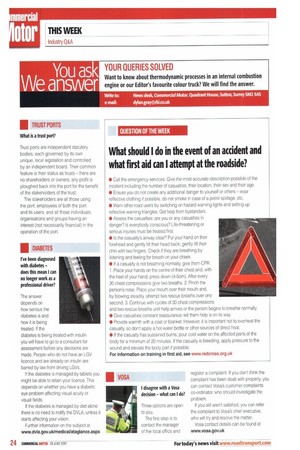What should I do in the event of an accident and what first aid can I attempt at the roadside?
Page 24

If you've noticed an error in this article please click here to report it so we can fix it.
• Call the emergency services. Give the most accurate description possible of the incident including the number of casualties, their location, their sex and their age.
• Ensure you do not create any additional danger to yourself or others wear reflective clothing if possible. do not smoke in case of a petrol spillage, etc.
• Warn other road users by switching on hazard warning lights and setting up reflective warning triangles. Get help from bystanders.
• Assess the casualties: are you or any casualties in danger? Is everybody conscious? Life-threatening or serious injuries must be treated first.
• Is the casualty's airway clear? Put your hand on their forehead and gently tilt their head back; gently lift their chin with two fingers. Check if they are breathing by listening and feeling for breath on your cheek.
• If a casualty is not breathing normally, give them CPR. 1. Place your hands on the centre of their chest and, with the heel of your hand, press down (4-5cm). After every 30 chest compressions give two breaths. 2. Pinch the person's nose. Place your mouth over their mouth and, by blowing steadily, attempt two rescue breaths over one second. 3. Continue with cycles of 30 chest compressions and two rescue breaths until help arrives or the person begins to breathe normally.
• Give casualties constant reassurance; tell them help is on its way.
• Provide warmth with a coat or blanket. However, it is important not to overheat the casualty so don't apply a hot-water bottle or other sources of direct heat.
• If the casualty has sustained burns, pour cold water on the affected parts of the body for a minimum of 20 minutes. If the casualty is bleeding, apply pressure to the wound and elevate the body part if possible.
For information on training in first aid, see www.redcross.org.uk






























































































































































































